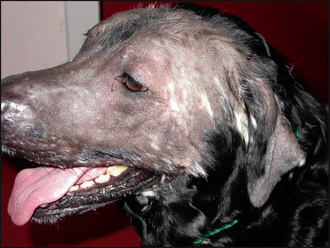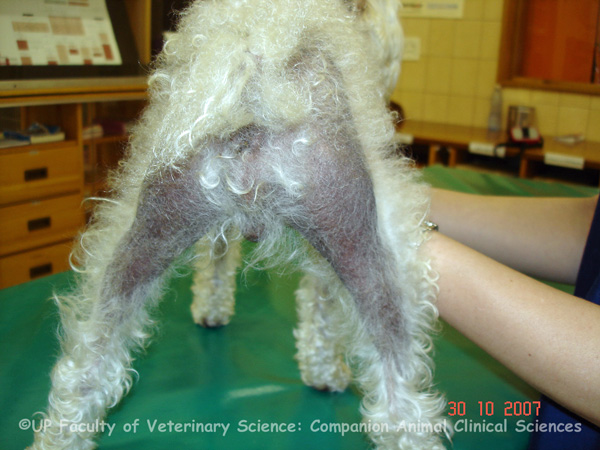Despite several case reports of canine AA in the literature there has been no systematic assessment of the disease in. 2 tiologie Die Ursachen der Alopecia areata sind nicht vllig geklrt.

Alopecia Areata In A Dog Clinical Dermoscopic And Histological Features Semantic Scholar
Acquired alopecia encompasses all other causes of hair loss.
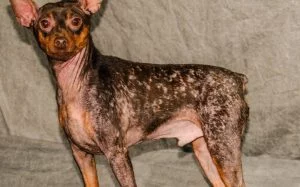
Dog alopecia areata. Background Alopecia areata AA is suspected to be an autoimmune disease directed preferentially against hair follicles HF affecting both humans and various mammalian species. What is Alopecia in Dogs. People are generally otherwise healthy.
The first step of the work-up of such condition consists in assessing that hair loss is real and that the appearance of the dog is not associated with self-trauma broken hair excoriations. The hair grows from the hair follicle. Recently two rodent models of AA were described namely the ageing C3HHeJ mouse and the DEBR rat.
Recently two rodent models of AA were described namely the ageing C3HHeJ mouse and the DEBR rat. In this type of alopecia the animal is born with a normal hair coat has or had normal hair follicles at one time and is or was capable of producing structurally normal hairs. Despite several case reports of canine AA in the literature there has been no systematic assessment of the disease in these companion animals and it is also not known whether dogs with AA.
Focal non-inflammatory alopecia. Canine alopecia is a condition that causes either partial or complete hair loss in dogs. Das erklrt auch weshalb man jedes Haar das sich an ihrem Krper befindet ohne Widerstand entfernen kann.
A diagnostic treatment challenge. The disease may cause psychological stress. Alopecia is defined as the loss of hair from areas of the body in which a normal hair coat is expected.
Alopecia areataist eine Erkrankung die sich durch Haarausfall in Flecken manifestiert und in einem einzigen Bereich sichtbar ist oder sich ber den gesamten Krper des Hundes ausbreiten kann. Der Anlaufstelle bei kreisrundem Haarausfall. Nun sieht es allerdings so aus als sei bereits sicher dass sie Alopcia areata hat - eine Autoimmunerkrankung bei der der Organismus Antikrper gegen die Haarfollikel entwickelt.
Detecting the cause and applying suitable treatment is necessary for the comfort of your pet. There are many causes of alopecia with some being easily fixed while others are caused by more chronic issues. Die Alopecia areata kurz AA ist ein akut einsetzender entzndlich bedingter Haarausfall ohne Vernarbung der Haarfollikel der sich meist in umschriebenen kreisrunden bis ovalen Bereichen der Kopfhaut manifestiert.
Acquired alopecia may be noninflammatory as is seen in endocrine alopecia pattern baldness alopecia X or some types of immune-mediated alopecia eg alopecia areata or. Alopecia areata also known as spot baldness is a condition in which hair is lost from some or all areas of the body. Dog hair plays an important role in protecting the dog from environmental hazards.
When the dog is shedding you may notice that his coat is thinning but there wont be actual bald patches as in the case of alopecia areata. Often it results in a few bald spots on the scalp each about the size of a coin. Alopecia in dogs is a term used in veterinary medicine to describe hair loss when it fails to grow at a normal pace or when there is a complete or partial absence of hair over the dogs body.
Background Alopecia areata is a Tcell mediated autoimmune disease that occurs in humans and various other mammalian species. When the disease progresses to total alopecia it is defined as alopecia. Alopezie ist eine Krankheit und sollte nicht mit der natrlichen Ausscheidung verwechselt werden die in den Eckzhnen saisonal ist.
Setzt sich aus engagierten ehrenamtlichen Mitgliedern zusammen die zwischen Betroffenen und Selbsthilfegruppen rzten Krankenkassen Perckenfirmen etc. Partial hair loss is often localized to certain areas of the dogs body. This condition is denoted by hair loss on a dogs flanks and back.
Alopecia occurs when this part becomes damaged or affected by an infection or inflammation or other underlying cause. In a few cases all the hair on the scalp is lost or all body hair is lost and loss can be permanent. Alopecia X is a condition of plush haired dogs like Pomeranians keeshonds and huskies and causes slowly progressive hair loss of mainly the trunk sparing the legs and head Figure 7.
Alopecia areata is a condition that manifests through hair loss in patches and can be seen in a single area or can be spread all over the dogs body. Left untreated alopecia can cause more than just hair lossAccording to PetMD alopecia can affect a dog or cats skin its endocrine system its lymphatic system and its immune systems. Alopecia areata AA is suspected to be an autoimmune disease directed preferentially against hair follicles HF affecting both humans and various mammalian species.
Herzlich Willkommen beim Alopecia Areata Deutschland eV. Take your pet for a vet check if you notice excessive hair loss. Alopecia areata is believed to be an.
However alopecia does not have to mean a lifetime of painful symptoms for your pet. Alopecia is a disease and shouldnt be confused with the natural shedding which is seasonal in canines. Auch die Symptomatik stimmt mit ihrem Erscheinungsbild berein.
The most common form of alopecia for dogs is seasonal alopecia also called cyclic follicular dysplasia. It can arise in young adults or older dogs and can be very disturbing. Alopecia is defined as areas of abnormal hair loss on a dog but these bald spots are typically signs of a bigger health issue.
Hair loss can also occur on the base of the tail nose and ears.

Ringworm In Dogs Is Actually Fungus It Lasts About 3 Weeks To Get Rid Of It
Neglected Dog With Hair Loss Found In Lanarkshire
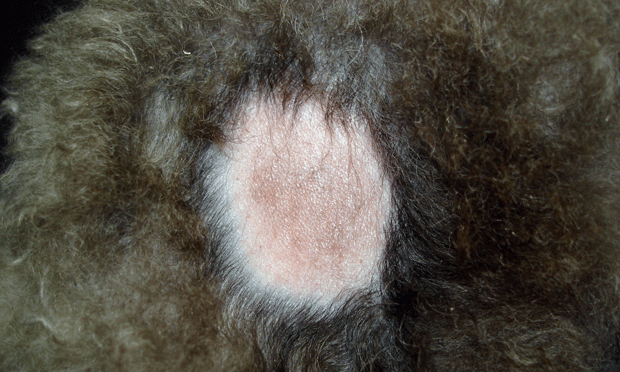
Canine Alopecic Dermatoses Clinician S Brief

Hair Loss In Dogs Types Causes Treatments The Honest Kitchen Blog
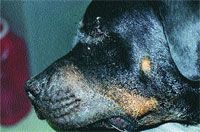
Focal Non Inflammatory Alopecia A Diagnostic Treatment Challenge

Hair Loss In Dogs Alopecia Symptoms Causes Diagnosis Treatment

Clinical Features Of Canine Alopecia Areata A Well Demarcated Download Scientific Diagram

Focal Non Inflammatory Alopecia A Diagnostic Treatment Challenge

Unresponsive Alopecia In An Older Dog Clinician S Brief
Alopecia And Hair Loss In Dogs
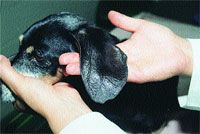
Focal Non Inflammatory Alopecia A Diagnostic Treatment Challenge

Leukotrichia In A German Shepherd Why Is My Black Dog Turning White Northeast Veterinary Dermatology Specialists

/GettyImages-695766398-f148c2b7e812451ca7bfc105e4297f9a.jpg)
:max_bytes(150000):strip_icc()/GettyImages-459679007-a0f5141ceadb42ada96994cc0e6b7e40.jpg)

